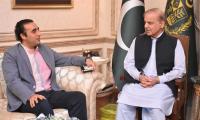LAHORE: Although the Election Commission of Pakistan has tried to hide behind an excuse that its new electronic results system suffered unexpected glitches soon after polling had ended in country's July 25, 2018 elections, it should take a leaf out of the book of Indian Election Commission, which had ably managed the world's biggest exercise in democracy in 2014 by facilitating a whopping 814.5 million voters who were eligible to exercise their right of franchise.
Compared to the 814.5 million voters managed by the Indian Election Commission, the total number of voters in Pakistan had rested at only 105.96 million, which was 23 per cent higher than the figures for the 2013 elections when the total number of voters had stood at 86.19 million, which thus meant that more than 19 million additional voters were registered for July 25, 2018 Pakistani ballot exercise.
The Indian general election of 2014 had seen members of parliament (Lok Sabha) getting elected for all 543 constituencies. An increase of 100 million voters was recorded since the last 2009 polls in India.
The average 2014 election turnout in India, over all nine phases was around 66.38 per cent, the highest ever in the history of Indian general elections. The BJP and its Hindu nationalist leader Narendra Modi had secured a crushing victory in this exercise.
On the contrary, in Pakistan, the voter turnout recorded in the July 25 National Assembly elections was 51.85 per cent. Pakistan had recently gone to polls for 849 directly elected seats, including 272 seats for the National Assembly.
A total number of 12,570 candidates had contested the elections for Pakistan's National Assembly and four provincial assemblies, compared to the 8,251 candidates who had contested the Indian elections under review.
In India, the counting exercise was held at 989 counting centres, while there were 1.4 million Electronic Voting Machines installed at 930,000 voting centres (up from 830,000 in 2009).
The scale of the Indian elections had required 1.1 million civil servants and 5.5 million civilian employees to handle the voting exercise. In Pakistan, there were 85,317 polling stations, comprising over 242,000 polling booths, and some 811,491 staffers were deployed for election duties as presiding officers, assistant presiding officers and polling officers, in addition to the 371,000 armed forces personnel who had provided security duties alongside police and other law enforcement agencies.
In India, the 2014 election was the longest and the most expensive general election in the history of the country, with the Election Commission of India estimating that the election did cost the exchequer Indian Rupees 35 billion (US$577 million), excluding the expenses incurred for security and by the individual political parties. The Indian political parties had spent Indian Rupees 305 billion (US$5 billion) in the election, which was three times the amount spent in the previous election in 2009, and was then the world's second highest after the US$7 billion spent on the 2012 American Presidential election.
In Pakistan, the July 25 were probably the costliest polling exercise in the country’s history, incurring expenses more than Rs21 billion to the national exchequer.
The amount exceeds the combined expense incurred during the two previous elections in 2008 and 2013. The total cost of the 2008 election was Rs1.84 billion. The expenditure soared by 157 per cent in 2013 when the election cost the country Rs4.73 billion. The recent election has cost the national exchequer three times more than the combined expenditure of the 2008 and 2013 elections.
Moreover, Rs21 billion is just an estimate. According to the Election Commission, the actual expenses would surface after the elections. The nature of electoral complaints during the Indian elections of 2009 and 2014:
It is imperative to note various Indian politicians had alleged that the election was rigged and accused the BJP and its workers of tampering with the Electronic Voting Machines (EVMs).
One of the prominent ones was when Assam Chief Minister Tarun Gogoi had alleged that Electronic Voting Machines had been tampered and said the Congress would take the issue up with the Election Commission.
During a mandatory mock poll in Jorhat city in Assam on April 3, 2014, every time a button was pressed, the vote went in favour of BJP. Congress MP Sanjay Nirupam, who was defeated in the Mumbai North constituency, had also blamed it on the Electronic Voting Machines.
Sanjay Nirupam had said: "Congress candidates have been defeated in Gujarat, Maharashtra and Uttar Pradesh with massive leads, which is not possible. The contract of the EVM had been given to a multi-national company based in Gujarat. This in itself is suspicious."
On May 16, 2014, social activist and Aam Aadmi Party candidate for the Mumbai North East constituency Medha Patkar had filed a complaint about the possible rigging of votes in her constituency. Her complaint with the election commission had stated that an address tag used to identify an EVM machine was found on the streets of Mumbai.
Late Bal Thackrey's political party--the Shiv Sena--had claimed that the total of the votes received by each candidate exceeded the total number of votes cast. In Mumbai, independent candidate Shrikant Shirsat also claimed that he got zero votes at the booth near his residence, alleging the EVMs were defective.
During the 2009 ballot exercise, the BJP had alleged that the party could not perform well because the EVMs might have been tampered with. After defeat, party’s then PM candidate L K Advani had raised questions about the credibility of the EVMs, and said that the country should go back to the older system of ballot papers Responding to such serious charges, the Election Commission of India then published a full-fledged report maintaining that the machines were secure and tamper-proof.
Not convinced, a politician Subramanian Swamy had moved the Indian Supreme Court on the issue, and the country's apex court had ordered the poll panel to introduce "paper trail" to EVMs throughout the country.







